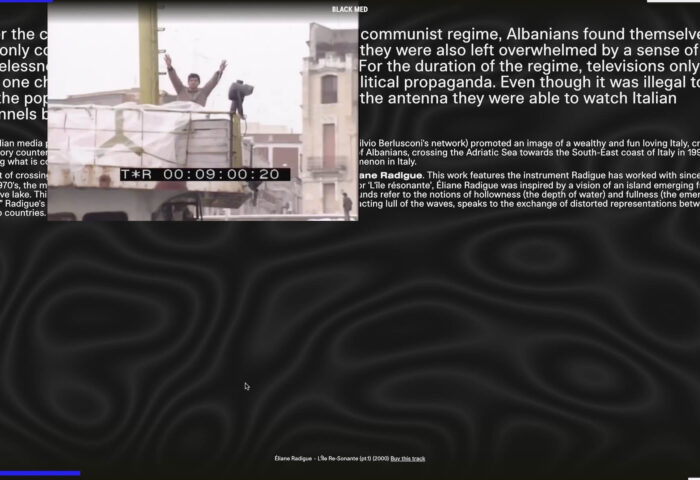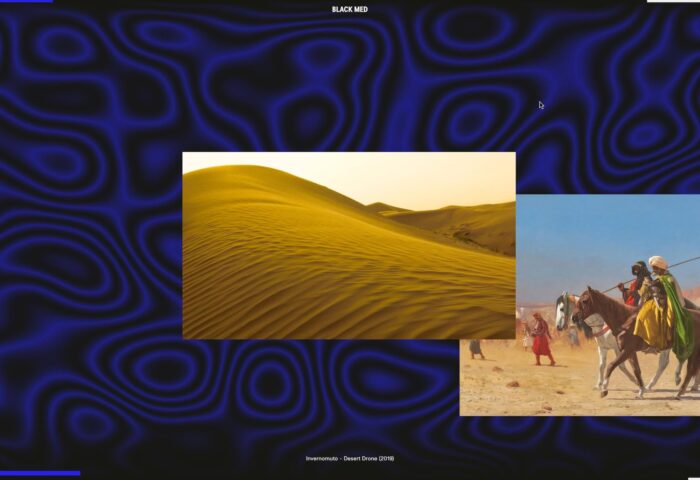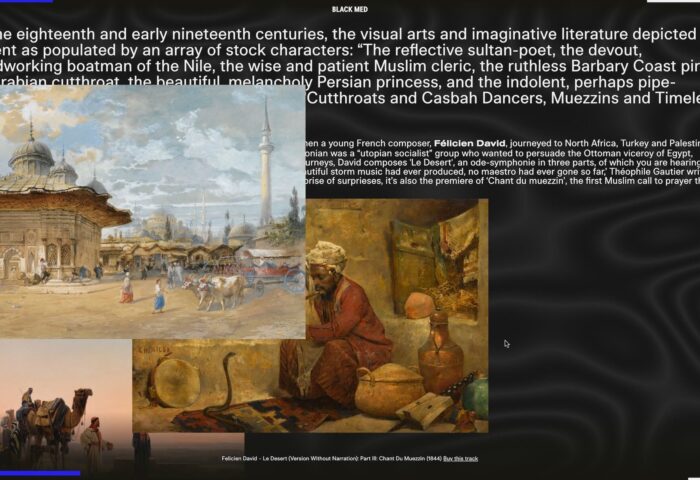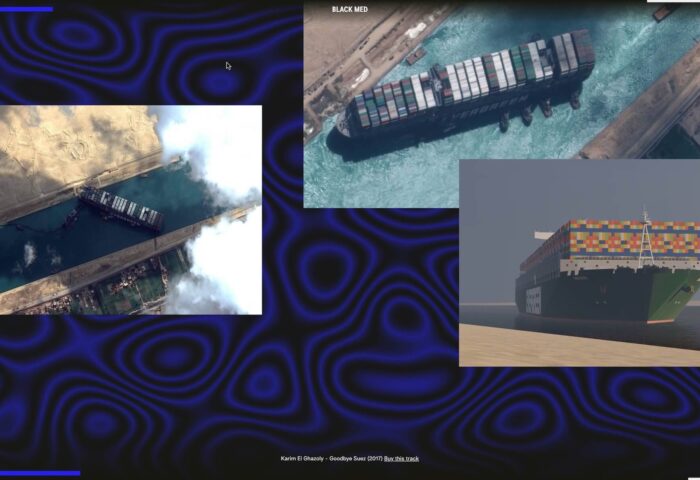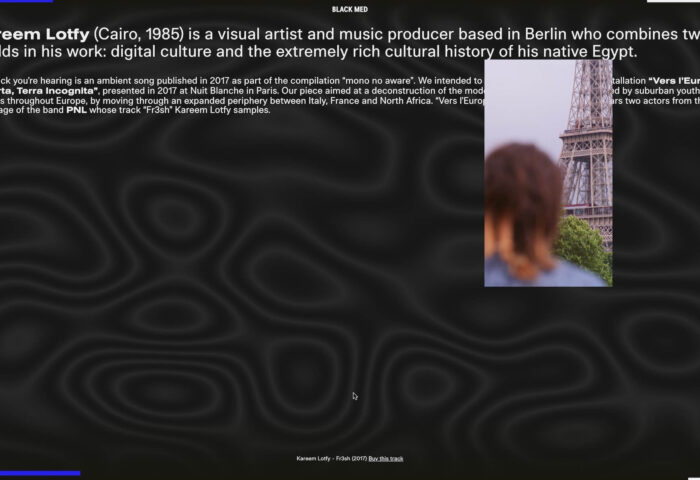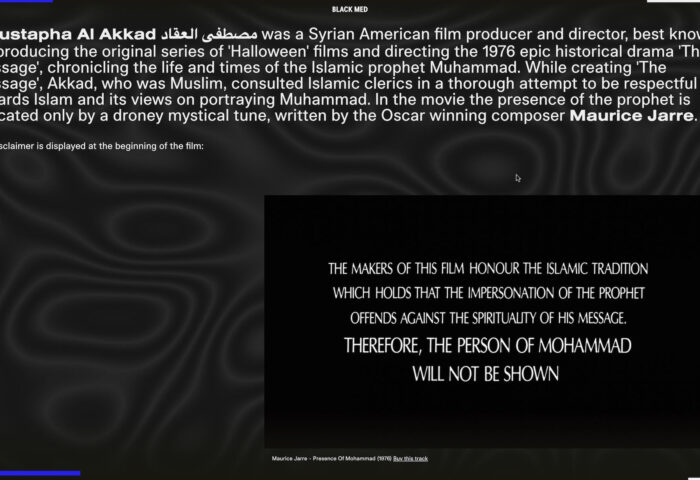For Invernomuto, Black Med is an ongoing research process which takes the form of a web platform called blackmed.invernomuto.info and which is structured in a cycle of works and events that share the provisional results. Black Med revolves around theoretical reflections on the Black Mediterranean, with reference to the research of Alessandra Di Maio (University of Palermo) who has used this definition in the context of postcolonial, migratory, transnational and diaspora studies in the field of contemporary African studies.
Invernomuto attempts to intercept the sound trajectories that cross the complex and stratified area of the Mediterranean, recording its continuous movements and accommodating the interweaving of its events and narratives. So Black Med navigates without following regular and categorical mapping. On the contrary, allows itself be crossed by the multiple routes and identities whose rhythms and sounds it listens to and archives. The trajectories followed by Black Med extend beyond the perimeter area of the Mediterranean in a strictly geographical sense, taking into consideration wider, more informal, unofficial geographies, proceeding from Marseilles to Barcelona, from Naples and Pompeii to Palermo, from Belgrade to Brindisi, from Cairo, the Suez Canal and Nubia to Lake Victoria, including the migration routes that have historically connected the African, Asian and European shores of the Mediterranean. In its protean composition Black Med appears as a mobile platform, launched in 2018 during the Manifesta 12 biennial in Palermo, and has continued with periods of Invernomuto’s residency at the American Academy in Rome and Alserkal Avenue in Dubai, and through a series of listening sessions in which the musical selection is accompanied by the projection of images and informative texts – including those at Centrale Fies (Dro), Dansem (Marseille), OGR and Fondazione Merz (Turin), the Triennale di Milano (Milan), the 58th October Salon-Belgrade Biennial 2020 (Belgrade), MACBA (Barcelona), TBA21-Academy Ocean Space (Venice), as well as within the performance programme of the 58th Venice Biennale, 2019. As an ongoing research project Black Med has also reformulated – through the Italian Council 2019 call for applications in which the duo participated upon presentation by the Fondazione Morra Greco (Naples) – adopting other modes of expression: a sound installation linked to the web platform blackmed.invernomuto. info and entitled Black Med, POMPEII, which has become part of the Collectio of the Archaeological Park of Pompeii; a printed publication that expands the project through a series of theoretical contributions (Humboldt Books, Milan); a programme of further presentations and listening sessions that took place during the development of the project at the international institutions acting as project partners: The Green Parrot (Barcelona) and the Centre d’Art Contemporain Genève (Geneva).
The blackmed.invernomuto.info platform (designed to be accessible both online – from 28 October 2021 – and offline, in the form of a sound installation) has collected, at the current stage of research, over thirty hours of content and musical contributions selected by Invernomuto, and a series of participants including Paul Gilroy, Rabih Beaini, Donato Epiro, Kareem Lotfy, Ma’an Abu Taleb and other musicians and researchers who were asked by the artists to propose a musical selection that would resonate with the research of Black Med. The project presented by Invernomuto for Pompeii Commitment. Archaeological Matters, published in these pages, further expands Black Med‘s online structure which involves the use of an algorithm especially created to “play” extracts from the project’s musical archive and combine them in an autonomous, continuously changing manner. The online platform includes an upload section that allows anyone to upload new musical tracks or sound recordings. The algorithm then acts as a DJ, selecting audio files from the archive and combining them through a series of instructions. The aim is not, however, that of profiling and controlling the habits of the user (the usual role of algorithmic logic) but of expanding them, bringing them together and sharing them in unexpected ways that are constantly redefined. But although, in this way, Black Med is configured as an archive, it is an archive in progress that is potentially infinite, that interprets the Mediterranean as a mare magnum of heterogeneous sounds and musical influences. As one of the contributors to the Black Med project, the anthropologist and sociologist Iain Chambers, wrote in 2012: “Music incites us to travel by adopting an overall less rigid view of the various disciplines, practices and institutions that together shape modernity. It provides an important case of deterritorialisation.” Being structured between different spaces and times, in the connection between the multiple Mediterranean cultures that the project claims are unpredictable and, in many respects, only documentable in a processual and non-definitive way, mixing objectivity and subjectivity, historical data and fantastic invention, Black Med also identifies the city of Pompeii as one point among others on a deterritorialized map: a syncretic and synaesthetic identity, at the same time rooted yet uprooted, specific yet composite, real yet fantastic, stable yet in progress, in the fluid and magmatic coexistence of the dances, songs, festivals, cries, evocations, music, prayers, rituals and sounds of the ancient and contemporary Mediterranean. AV
Project supported by the Italian Council (7th Edition, 2019), program to promote Italian contemporary art in the world by the Directorate-General for Contemporary Creativity of the Italian Ministry of Culture.


